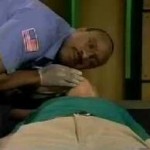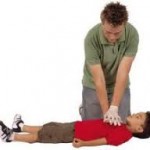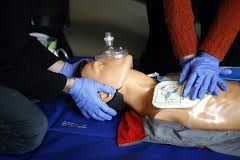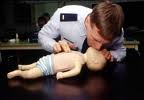Performing proper CPR or cardio-pulmonary resuscitation during an emergency situation is very important for anybody to know because you’ll just never know when you just might need it. CPR is vital because its primary goal is to continue pumping oxygenated blood to every part of the patient’s body when the heart stops functioning. While you wait for the paramedics to arrive, cardio-pulmonary resuscitation should be performed. This assures the high chances of the patient to live especially after a cardiac arrest.
Many lives have already been saved by performing proper American Red Cross CPR steps. These steps have been developed and taught to many individuals who have volunteered to save other people’s lives. If you want to know how to properly conduct these procedures, you should have the courage and the presence of mind. In a cardiac arrest, the patient suddenly has n heartbeat, becomes unconscious, and breathing stops. Here are the tips that you have to take note when you perform American Red Cross CPR steps:
1. Check airway
 The primary thing that you have to do in American Red Cross CPR steps is to check the airway. It is important to do this first because if the patient breathes, then oxygen could still reach the brain. If the brain is oxygenated, then there is less chance for brain damage to occur. You should call out to the victim and see if he or she is conscious. If the person has not sustained any neck injury, then you could simply lift the chin and tilt the head to listen to breathing sounds. If ever the patient has neck injury, you could just lift the chin and not tilt the head back anymore. Listening for breath sounds could be done for about ten seconds just to make sure.
The primary thing that you have to do in American Red Cross CPR steps is to check the airway. It is important to do this first because if the patient breathes, then oxygen could still reach the brain. If the brain is oxygenated, then there is less chance for brain damage to occur. You should call out to the victim and see if he or she is conscious. If the person has not sustained any neck injury, then you could simply lift the chin and tilt the head to listen to breathing sounds. If ever the patient has neck injury, you could just lift the chin and not tilt the head back anymore. Listening for breath sounds could be done for about ten seconds just to make sure.
2. Rescue breathing
 American Red Cross CPR steps also involve rescue breathing. This is after you have assessed that the victim has no signs of breathing at all. Before you give rescue breaths, you must first pinch the victim’s nose, lift the chin to tilt the head slightly. Then you should just breathe normally before you give rescue breathing. This is to slowly incorporate your breath into the victim’s air passages. Deeply breathing before giving rescue breaths might just fill the victim too fast. Each breath should only last a second, just enough for you to see a rise on the victim’s chest. Lift the chin again and perform rescue breaths if the chest isn’t rising.
American Red Cross CPR steps also involve rescue breathing. This is after you have assessed that the victim has no signs of breathing at all. Before you give rescue breaths, you must first pinch the victim’s nose, lift the chin to tilt the head slightly. Then you should just breathe normally before you give rescue breathing. This is to slowly incorporate your breath into the victim’s air passages. Deeply breathing before giving rescue breaths might just fill the victim too fast. Each breath should only last a second, just enough for you to see a rise on the victim’s chest. Lift the chin again and perform rescue breaths if the chest isn’t rising.
3. Chest compressions
 In American Red Cross CPR steps, you must kneel right beside the victim. Then, you should trace the notch where the bottom ribs unite. Then you place the heel of your hand, on the sternum, right in the middle of the chest, between the nipples. Place your other hand on top of the first hand, interlacing your fingers. You should then press downwards with your arms straightened. There should be a rest in between compressions. Usually, it is two breaths for every thirty compressions.
In American Red Cross CPR steps, you must kneel right beside the victim. Then, you should trace the notch where the bottom ribs unite. Then you place the heel of your hand, on the sternum, right in the middle of the chest, between the nipples. Place your other hand on top of the first hand, interlacing your fingers. You should then press downwards with your arms straightened. There should be a rest in between compressions. Usually, it is two breaths for every thirty compressions.
4. CPR for infants
According to American Red Cross CPR steps, you should not tilt the head of an infant (up to a year old) too far back because this might just block the infant’s air passages more. Do not pinch the infant’s nose. Instead, cover the infant’s nose and mouth with your mouth when you give rescue breaths. This will make the chest rise. Five cycles of CPR should be given to the infant two minutes before calling for help. You could just use the tips of your ring and middle fingers for chest compressions. Use your other hand to support the infant’s back.
5. CPR for children
 In performing American Red Cross CPR steps on children from one to eight years of age, the same steps for an adult applies. Only this should be done with two cycles, two minutes before the emergency call and should be continued until paramedics arrive.
In performing American Red Cross CPR steps on children from one to eight years of age, the same steps for an adult applies. Only this should be done with two cycles, two minutes before the emergency call and should be continued until paramedics arrive.
In American Red Cross CPR steps, proper assessment should be done. This makes sure of the real condition of the patient and lets you perform the needed rescue steps properly. Learning how to administer CPR on anyone under any age group makes you very knowledgeable in saving a life. You may not be a healthcare professional but the dedication and the passion that you have to save people you don’t even know makes you more than equipped in performing American Red Cross CPR steps. It is good to update your training every now and then to keep up with the latest trends in American Red Cross CPR steps.

